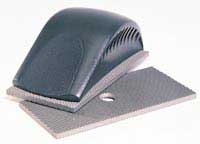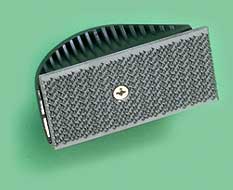|
Sand Shark |

|
|
Review by Chuck Gottfried - Fall Creek, Oregon - USA |
 I used to always carry a 4-in-1 wood rasp in my shop apron pocket, and used it all the time. You know the one, ½ oval on one side, coars and fine faces, available just about anywhere they sell hardware. I used it frequently - rounding a corner, scraping a bit of glue, or easing that last little bit out of a wood joint. Now, I don’t carry a rasp. I carry a Sand Shark. I used to always carry a 4-in-1 wood rasp in my shop apron pocket, and used it all the time. You know the one, ½ oval on one side, coars and fine faces, available just about anywhere they sell hardware. I used it frequently - rounding a corner, scraping a bit of glue, or easing that last little bit out of a wood joint. Now, I don’t carry a rasp. I carry a Sand Shark.
Nicholson’s Sand Shark is like a cross between that rasp, a block plane, and a sanding block on steroids. It consists of a steel plate, tooled to resemble the business side of a wood rasp. The plate, approximately 2” x 4”, is secured to a plastic handle like that of a rubber sanding block, the kind with the little teeth embedded in the slot to hold the paper. The steel plate is attached to the handle with a single recessed screw, and is easily reversed to double its useful life.
 In practice, the Sand Shark is incredibly versatile; it works like coarse sandpaper to remove wood, plastic, or fiberglass (especially fiberglass!). It handles like a block plane to ease corners, with the contoured handle providing good control. The steel plate is perfectly flat and square-ended, allowing it to get into right-angled corners to clean out glue, varnish, or paint, and is sharp enough on the edges and corners to act as a scraper in tight spots. In practice, the Sand Shark is incredibly versatile; it works like coarse sandpaper to remove wood, plastic, or fiberglass (especially fiberglass!). It handles like a block plane to ease corners, with the contoured handle providing good control. The steel plate is perfectly flat and square-ended, allowing it to get into right-angled corners to clean out glue, varnish, or paint, and is sharp enough on the edges and corners to act as a scraper in tight spots.
Where I find this tool really shines is when working with epoxy. I use epoxy frequently, and so continually battle with removing the hardened ‘squeeze-out’, or overflow from laminating or filling fabric. The evil stuff sags, drips, and runs, and as you know, once it’s set, it takes a good sharp tool or lots of sanding to make it right. The Sand Shark’s rasp-like surface makes short work of sags and runs on flat surfaces, and the sharp edges allow you to get nice, square corners on glue joints that don’t get filleted.
Because the plate has teeth on both sides and is easily reversable, you get twice the life out of the cutting surface. That’s nice, because, while the sharp surface stays sharp a long time, I managed to finally lose the keen edge, requiring a lot more muscle to remove those glue puddles. Simply remove the single screw, flip the cutting plate over, and you’re back in business. Mine lasted almost a year in heavy use before its cutting edges got dull. Until then, it requires only an occasional brushing with a wire brush to clean the grooves and restore its usefulness.
My local supplier stocks two types – a ‘coarse’ and a ‘medium’ model. I initially bought the medium, which I like, but recently purchased the coarse to give it a try. Its very rough surface looks intimidating, and without care, may leave some serious scratches to remove. But at only $20, I may just get another medium one, and have both. They greatly outlast sandpaper, and work better than anything else on epoxy drips and sags.
I mentioned to my supplier how great these tools were, and how much time and effort they save in the boatshop. He indicated that they don’t sell many, and may drop them completely. That would be a shame, because this cleverly-designed and well-built tool belongs in everyone’s toolbag.
|